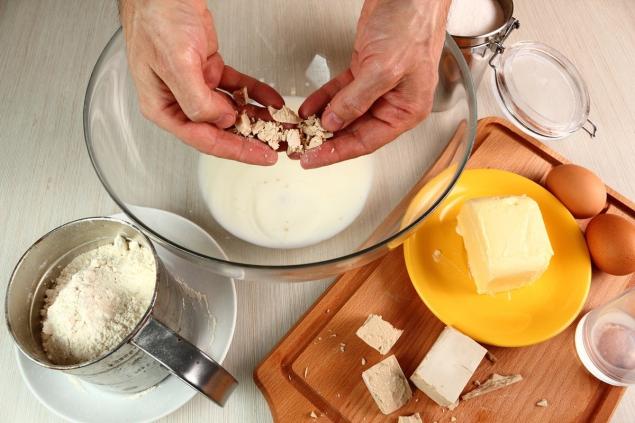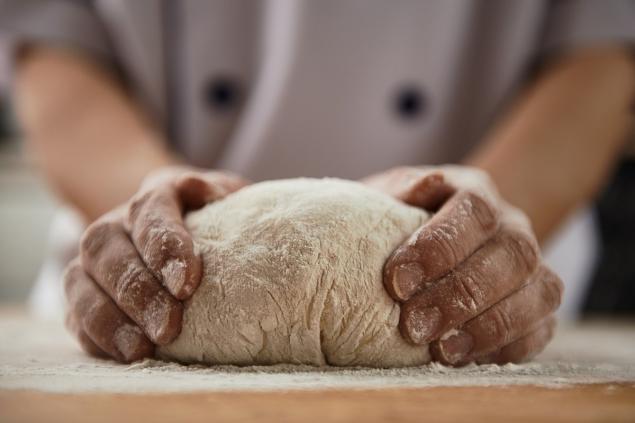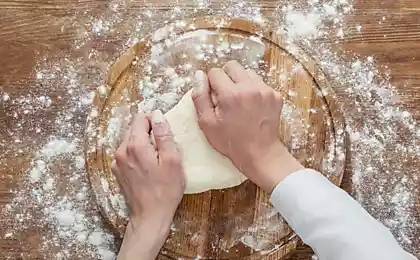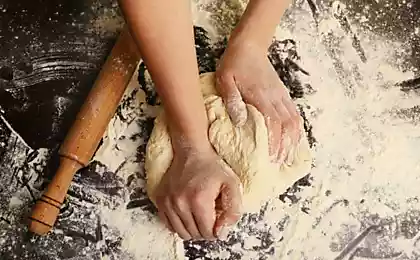287
Why does the yeast dough fail?
Yeast is probably one of the oldest “domestic organisms.” For thousands of years, people have used them for fermentation and baking.

But even such a long acquaintance did not make the use of these single-celled fungi simple and understandable. Since school years, we know that to activate yeast, it is enough to provide them with heat, water, food and oxygen.
But on the culinary forums you can read the following: “Yeast feels negativity, does not like fatigue, it transmits human energy, irritation and other negative emotions. In such moments, it is better not to start with the test.” Is that true?

"Site" Consider 10 rules, following which you can make friends with yeast dough and please home airy, soft and tasty pastries.
In yeast dough, everything is important: temperature, quality of products, cooking sequence, excess or lack of ingredients. All of this may be the reason why dough doesn't go upIt is too dry or too hard.
We wish you to make friends with yeast and master the art of making yeast dough, so that cakes always turn out only of excellent quality!

But even such a long acquaintance did not make the use of these single-celled fungi simple and understandable. Since school years, we know that to activate yeast, it is enough to provide them with heat, water, food and oxygen.
But on the culinary forums you can read the following: “Yeast feels negativity, does not like fatigue, it transmits human energy, irritation and other negative emotions. In such moments, it is better not to start with the test.” Is that true?

"Site" Consider 10 rules, following which you can make friends with yeast dough and please home airy, soft and tasty pastries.
In yeast dough, everything is important: temperature, quality of products, cooking sequence, excess or lack of ingredients. All of this may be the reason why dough doesn't go upIt is too dry or too hard.
- Temperature.
The optimal temperature for yeast fermentation is 30-38 degrees. At a temperature of 45-50 degrees and above, yeast cells die. If the water is cold, the fermentation process will not begin. If it is too hot, the yeast will die, perhaps partially. The dough will rise for a long time, it will turn out heavy, dense.
The temperature of the other ingredients is also important. Eggs, butter and flour should be indoor or slightly above temperature. Frozen yeast retains its properties if it is slowly thawed at a temperature of 6-8 degrees. - Choosing yeast
Yeast can be fresh pressed, dry and fast acting. Pressed yeast should have a uniform cream color, when pressed, they should break, not smear.
Like all living organisms, fresh yeast should “breathe”, without access to air, they quickly deteriorate, so you should not store them in an airtight package. At room temperature, such yeast is stored no more than a day, in the refrigerator (at 0-4 degrees) - up to 12 days.
Dry active yeast They do not need cooling, their shelf life is 1-2 years. They are often confused with fast-acting and, when used, are simply mixed with flour. But before applying these yeasts, they must be removed from the “sleeping mode” by mixing them with warm sweet water, milk or whey.
Fast-acting (or instant) yeast is the latest generation. Such yeast should not be diluted in water and can be immediately added to the finished dough, mixing with a small amount of flour. In fast-acting yeast, there is a powerful potential for dough growth: it rises one and a half to two times faster. - Sequence of action
When using any yeast, the first thing to do is check their quality. For rapid testing, mix a small amount of yeast with warm (30-35 degrees) water, stir well and leave for 10-15 minutes alone.
During this time, the yeast should “play”, and the mixture is covered with foam. If there is no movement, then yeast is not good, you should not waste energy and translate products in vain. Yeast dough is made in two ways - with and without steam.
If you want the dough to be sweet (more eggs, sugar, butter, milk), then cook it with a steam (suitable for pies, buns, cakes, buns). For the opar, water, sugar, yeast and a little (a couple of spoons) flour are mixed, covered with a towel and sent to stand warm for about an hour.
The dough prepared in this way is more elastic, and the air bubbles in it are larger. But salt stops the action of yeast, so it can not be added at the stage of opar. Add salt at the very end of the dough mix when the remaining ingredients have already been added.
The steamless dough is kneaded immediately, you just need to wait so that it fits well. It is more suitable for baking cakes, buns, everyone’s favorite pizza, yeast pancakes and pancakes, deep-fried donuts. - Number of ingredients
Even after kneading, the yeast dough should remain soft and slightly sticky. If there is a lot of flour, baking will turn out hard, will rise poorly. If the flour is small, the dough will spread, will not keep shape and stick strongly to the hands, it will be difficult to work with it. In addition, the liquid dough rises and oxidizes too quickly.
If the oil is more than normal, the dough will become heavy, more yeast will be needed. If there is not enough sugar, the yeast is not activated. But it is better not to add more sugar than normal, otherwise the fermentation process slows down. - The dough becomes hard.
The reason may be more than in the recipe, the amount of flour and eggs. Maybe the dough didn't fit well or you didn't let it spread properly.
In addition to yeast, you can add a small amount of baking powder, just one teaspoon per kilogram of flour. The dough is porous, soft, while the taste does not change. - The dough is rubbery.
It's all about the wrinkle, or rather, in insufficient wrinkle. In the process of fermentation, yeast emits carbon dioxide, which forms bubbles and causes the rise of the dough. But with excess carbon dioxide, the fermentation process slows down.
To fix this, the dough is kneaded. At the same time, excess carbon dioxide leaves the dough, and in addition, it is enriched with oxygen. If the dough is prepared with eggs and butter, it must be washed 2-4 times depending on the amount of muffin. - The dough is dry.
Perhaps the dough is clogged with flour. To avoid this, you need to intervene flour gradually until you get the desired consistency. It could also be that you didn't let the test stand up enough and rebuild the structure after another kneading. - The dough breaks
The structure of the test depends on how and how much it was stirred. And how long it's been wandering. That is why it is worth giving the test the time specified in the recipe for dissolution. - The dough sticks to parchment paper
Usually too liquid dough or dough sticks, in which there is not enough oil. In this case, it will be correct to lubricate the paper with oil or even sprinkle flour on top of the oil.
- The dough in the oven first rises, and then falls
Most often this is a test reaction to temperature changes. You often open the oven door, pull out and check what happens. And in the end, subsidence. The reason may also be that the dough was not standing enough, or the temperature was not enough for the development of yeast.
We wish you to make friends with yeast and master the art of making yeast dough, so that cakes always turn out only of excellent quality!






























